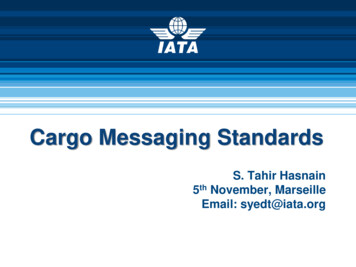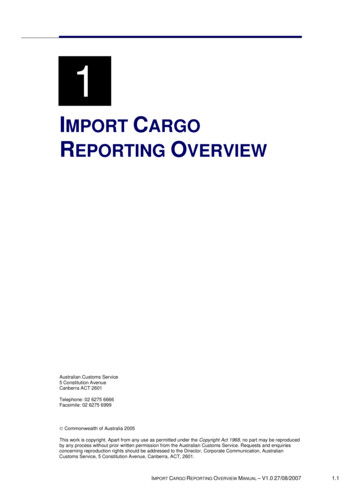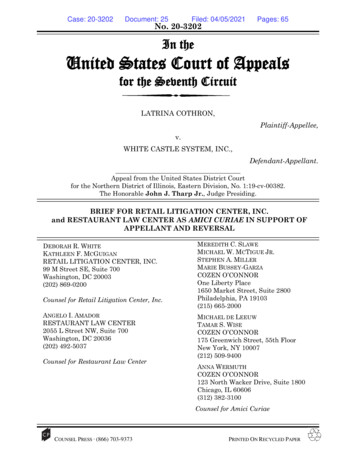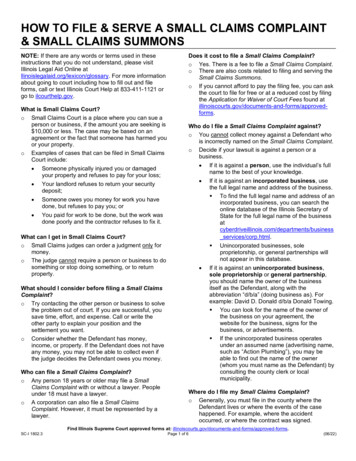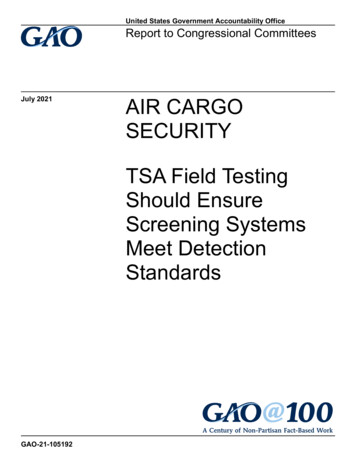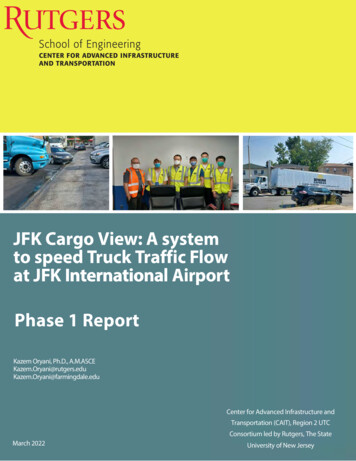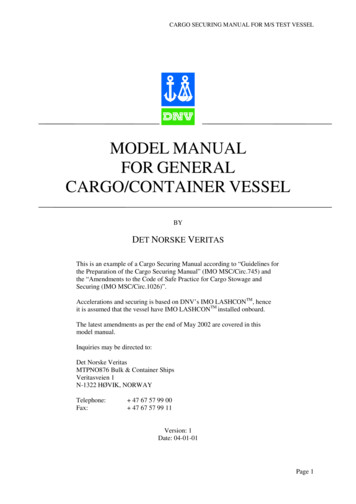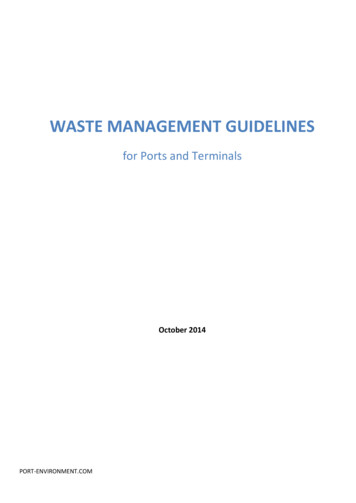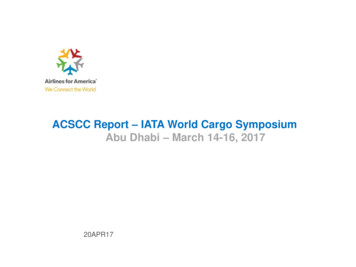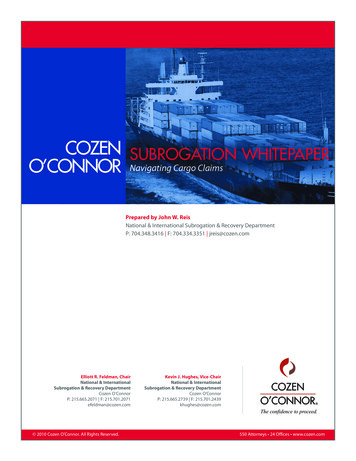
Transcription
COZEN SUBROGATION WHITEPAPERO’CONNOR Navigating Cargo ClaimsPrepared by John W. ReisNational & International Subrogation & Recovery DepartmentP: 704.348.3416 F: 704.334.3351 jreis@cozen.comElliott R. Feldman, ChairNational & InternationalSubrogation & Recovery DepartmentCozen O’ConnorP: 215.665.2071 F: 215.701.2071efeldman@cozen.comKevin J. Hughes, Vice-ChairNational & InternationalSubrogation & Recovery DepartmentCozen O’ConnorP: 215.665.2739 F: 215.701.2439khughes@cozen.comThe confidence to proceed. 2010 Cozen O’Connor. All Rights Reserved.550 Attorneys 24 Offices www.cozen.com
TABLE OF CONTENTSINTRODUCTION .1KEY TERMS TO CARGO CLAIMS.1MARINE CLAIMS .2THE ICC TERMINATION ACT (Formerly known as the Carmack Amendment).2History .2Application .2Purpose .2Effect .2The Elements.3Recoverable Damages .3yWhat the Statute ProvidesyWhat the Case Law SaysyMarket Value is Prevailing Measure of DamageyTime at Which Market Value is EstablishedyReasonablenessyBurden of Proving Market Value DamagesyPartial DamageyCarrier Can Be Estopped from Challenging DamagesyExceptions to Market Value as Measure of DamageyLost ProfitsyWholesale Price v. Market Price v. Invoice PriceyCases Where Damages Sought Were DeniedyPrejudgment InterestLimits of Liability.6Nine‐Month Notice Requirement .6Specification of the Dollar Amount .6Sample Notice Letter.7Statute of Limitations.8Broker Liability Under Carmack and Common Law.8yWhat is a broker?yCommon law theories against brokersyConclusionTHE CARRIAGE OF GOODS BY SEA ACT (COGSA) .11History .11Purpose .11Scope .12Duties Imposed by COGSA .12Protections to the Shipper or Carrier .12yLimit of Liability to 500 per “package”yThe 17 other protectionsCONFLICTS BETWEEN COGSA AND CARMACK .15AIR TRANSPORT CARGO CLAIMS .17THE WARSAW CONVENTION.17THE MONTREAL CONVENTION.17CONCLUSION .18 2010 Cozen O’Connor. All Rights Reserved. Comments in this article are not intended to provide legal advice. The analysis, conclusions,and/or views expressed herein do not necessarily represent the position of the law firm of Cozen O’Connor or any of its employees, or theopinion of any current or former client of Cozen O’Connor. Readers should not act or rely on information in this article without seekingspecific legal advice from Cozen O’Connor on matters which concern them.
INTRODUCTIONThe term “cargo claim” is a broad one. Such claims are ancient with a long history of laws written and re‐written toaddress them. Cargo claims can invoke “maritime law,” another broad and sometimes elusive term. Claims forcargo lost or damaged on land, never touching a drop of water, are often called marine cargo claims nonetheless.And cargo claims can also invoke “air law” – laws governing air travel.Most cargo claims are covered by marine insurance. Marine insurance covers, among other things, thetransportation of cargo on land, sea or air. Claims for loss and damage to cargo under a marine insurance policy,when paid, give rise to subrogation, by which the insurer gets an opportunity to try to collect back from theparty(ies) responsible for the loss or damage. Through subrogation, the insurer gets to “stand in the shoes” of theinsured, who is most often the owner of the cargo.When the cargo owner (usually the insured) entrusts the goods to someone for storage or transportation, abailment is created. If the goods move from or to the United States, internationally by ocean, that bailmentrelationship is controlled by the Carriage of Goods by Sea Act (COGSA), a statute of the United States. Internationalshipments, not touching a U.S. port, may be controlled by other treaties, such as Hague‐Visby or Hamburg Rules.Interstate and transportation of cargo by rail, truck and barges are generally covered by the Pomerene Act andCarmack Amendment to the Interstate Commerce Act.International air shipments are governed by the Montreal Convention, MP‐4, or the Warsaw Convention.Some personal injury claims are governed by the Jones Act and the Longshoremen and Harbor Workers’Compensation Act (LHWCA), which are left for another day.KEY TERMS TO CARGO CLAIMSCargo claims involve terms unfamiliar to the uninitiated, but which are key to understanding the claims under whatis called the Carmack Amendment and COGSA. Such terms include:y“BILL OF LADING”: This is a key document for cargo claims. A bill of lading generally serves three purposes: (1)document of title; (2) a contract of carriage and (3) a receipt for goods. Ocean bills can be negotiableinstruments and control possession of the goods.y“MANIFEST” is similar to a packing list. It identifes what was packed and/or stuffed into a containery“SHIPPER” has been defined as “one who ships goods to another” and “one who tenders goods to a carrier fortransportation.” Black’s Law Dictionary, 7th Ed. 1983.y“CARRIER” has been defined as “an individual or organization (such as a railroad, ocean vessel or an airline)that transports passengers or goods for a fee.” Id.yThe term “PRIVATE CARRIER” refers to a carrier that transports or delivers goods or services for a single entity,often a corporation. Usually that entity's primary business is not transportation but rather something else. Forexample, a grocery store chain may own and operate its own private fleet to deliver produce and goods totheir stores. That grocery store chain’s primary business is not transportation but grocery retail. Its fleet is a aprivate carrier.yThe term “COMMON CARRIER” refers to a carrier whose primary business is the transport of goods and whichserve any customers that hire them, such as buses, railroads, trucking companies, airlines and taxis. Privatecarriers may refuse to sell their services at their own discretion, whereas common carriers must treat allcustomers equally. Examples of a common carrier are Federal Express and United Parcel Service.yThe term “INDEPENDENT CARRIER” refers to an individual owner‐operator or trucker who may make dealswith private carriers, common carriers, contract carriers, or others as he or she wishes. 2010 Cozen O’Connor. All Rights Reserved.1
NAVIGATING CARGO CLAIMS Subrogation WhitepaperyThe term “CONSOLIDATOR” applies to a company that organizes and often loads into a single container,different cargoes, to obtain lower freight charges. Consolidators can be found to be carriers if they issue a billof lading, such as Non Vessel Ower Common Carriers (NVOCC’s) or Indirect Air Carriers.y“BROKER”: “The term ‘broker’ means a person, other than a motor carrier or an employee or agent of a motorcarrier, that as a principal or agent sells, offers for sale, negotiates for, or holds itself out by solicitation,advertisement, or otherwise as selling, providing, or arranging for, transportation by motor carrier forcompensation.” 49 U.S.C. §13102(2).MARINE CLAIMSTHE ICC TERMINATION ACT (FORMERLY KNOWN AS THE CARMACK AMENDMENT)What was traditionally known as the Carmack Amendment is codified at 49 U.S.C. Section 14706 et seq. It is nowknown as the ICC Termination Act. It provides the sole and exclusive remedy to shippers for loss or damage ininterstate transit. Hughes Aircraft v. North American Van Lines, 970 F.2d 609, 613 (9th Cir. 1992).HistoryThe Carmack Amendment was enacted by Congress in 1906 as an amendment to the Interstate Commerce Act of1887 to provide for national consistency for goods damaged or lost during interstate shipment by a commoncarrier. Ward v. Allied Van Line, Inc., 231 F.3d 135, 138 (4th Cir. 2000). The Interstate Commerce Commission wasabolished by Congress in 1995 with the ICC Termination Act, “but the old ICC regulations remain in effect until thenew regulations are promulgated.” John Deere Insurance Co. v. Nueva, 229 F.3d 853, 855 n. 3 (9th Cir.2000). TheICC Termination Act also recodified the Carmack Amendment at 49 U.S.C. § 14706 from 49 U.S.C. § 11707 (1995).“This recodification worked no substantive change on the Carmack Amendment.” Project Hope v. M/V Ibn Sina,250 F.3d 67, 73 n.4 (2d Cir. 2001).ApplicationThe Carmack Amendment applies to transportation of goods between states, unless the shipment is within acommercial free trade zone, which is usually about a 50 mile radius from a specified point. Trucks delivering withinsuch a zone are virtually unregulated and can set forth, for example, a 50 per shipment limitation of liability.PurposeThe purpose of the Carmack Amendment was to provide “a uniform system of carrier liability that would providecertainty to both carrier and shipper by enabling the carrier to asses its risk and predict its potential liability fordamages.” Pietro Culotta Grapes v. Southern Pacific Transportation, 917 F.Supp. 713, 716 (E. Dist. Cal. 1996).EffectIf applicable, Carmack “preempts a shipper’s state and common law claims against a carrier for loss or damage togoods during shipment. Ward v. Allied Van Lines, Inc., 231 F.3d 135, 138 (4th Cir.2000)(citing Shao v. Link Cargo)(Taiwan) Ltd., 986 F.2d 700, 704 (4th Cir.1993)). It makes carriers liable “for the full actual loss, damage, or injurycaused by them to property they transport, and declares unlawful and void any contract, regulation, tariff, or otherattempted means of limiting this liability.” Missouri Pacific Railroad Co. v. Elmore & Stahl, 377 U.S. 134, 137, 84S.Ct. 1142, 1144 (1964). The broad reach of Carmack preempts plaintiff’s state law claims, which includes claimsfor: 1) the tort of outrage; 2) intentional and negligent infliction of emotional distress; 3) breach of contract; 4)breach of implied warranty; 5) breach of express warranty; 6) violation of the state’s deceptive trade practices orconsumer protection statutes; 7) slander; 8) misrepresentation; 9) fraud; 10) negligence and gross negligence; and11) violation of the common carrier’s statutory duties as a common carrier under state law. Hoskins v. Bekins VanLines, 343 F.3d 769, 777 (5th Cir. 2003). Carmack also preempts federal common law that increases the carrier’sliability. 2010 Cozen O’Connor. All Rights Reserved.2
NAVIGATING CARGO CLAIMS Subrogation WhitepaperThe ElementsTo make a prima facie case under the Carmack amendment, “a plaintiff must show 1) delivery to the carrier ingood condition; 2) arrival in damaged condition; and 3) the amount of damages caused by the loss.” Project Hopev. M/V Ibn Sina, 250 F.3d 67, 73 (2d Cir. 2001) “Once the prima facie case is established, liability attaches unlessthe carrier can establish one of several affirmative defenses.” Id. These available affirmative defenses are that thedamage was caused by (a) the act of God; (b) the public enemy; (c) the act of the shipper himself; (d) publicauthority; or (e) the inherent vice or nature of the goods.” Missouri Pacific Railroad Co. v. Elmore & Stahl, 377 U.S.134, 137, 84 S.Ct. 1142, 1144 (1964). “The burden of proof is upon the carrier to show both that it was free fromnegligence and that the damage to the cargo was due to one of the excepted causes relieving the carrier ofliability.” Id. at 138, 84 S.Ct. at 1145.Recoverable DamagesWhat the Statute ProvidesA plaintiff suing under the Carmack Amendment is entitled to the “actual loss or injury to the property caused by.the carrier.” 49 U.S.C. § 14706(a)(1).What the Case Law Says“The Carmack amendment incorporates common law principles for damages.” Project Hope v. M/V Ibn Sina, 250F.3d 67, 76 (2d cir. 2001). Carmack makes carriers liable “for the full actual loss, damage, or injury caused by themto property they transport, and declares unlawful and void any contract, regulation, tariff, or other attemptedmeans of limiting this liability.” Mo. Pac. R.R. Co. v. Elmore & Stahl, 377 U.S. 134, 137 (1964). If the loss is acomplete loss, the general measure of damages under Carmack is the fair market value at the place of destination.Illinois Cent. R.R. Co. v. Caril, 281 U.S. 57, 50 S.Ct. 180 (1930).Market Value is Prevailing Measure of DamageThe goal in an action for cargo damage is to restore the innocent party to the position the party would have beenin if the contract had been fully performed. Hector Martinez & Co. v. Southern Pac. Transp. Co., 606 F.2d 106, 108(5th Cir. 1979). Where goods are damaged, the general rule for damages is the difference between the marketvalue of the shipment at its destination and the market value of the shipment as damaged. Fujitsu Ltd. v. FederalExpress Corp., 247 F.3d 423, 435 (2d cir. 2001). Where the damage is a total loss, the measure of damages is thefair market value at destination less salvage. Encylcopaedia Britannica v. S.S. Hong Kong Producer, 422 F.2d 7, 19(2d Cir. 1969). Market value is also an appropriate measure of damages under COGSA. Van Der Salm Bulb Farms,Inc. v. Hapage Lloyd, A.G., 818 F.2d 699, 700 (9th Cir. 1987).Time at Which Market Value is EstablishedThe measure of damages where a carrier fails to deliver a shipment at a destination within a reasonable time is thedifference between the market value of the goods at the time of delivery and the time when they should havebeen delivered. Nat’l Hispanic Circus, Inc. v. Rex Trucking, Inc., 414 F.3d 546, 552 (5th Cir. 2005).If goods which arrive at destination damaged are returned to the shipper for inspection, a court has held that ithad no basis for determining that the damage was not caused, or at least aggravated, during the second part of thejourney. S.C. Johnson & Son, Inc., v. Louisville & Nashville R. Co., 695 F.2d 253 (7th Cir. 1982).In Neptune Orient Lines v. Burlington, 211 F.3d 1118 (9th Cir. 2000), the court held that the measure of damagesunder the Carmack Amendment for the loss of a container load of Nike shoes on the inland portion of a carriagefrom Indonesia to Tennessee was the market value at destination, not the replacement cost. The Court stated,“Market value at destination" is the proper measure of the actual loss in a situation where, as here, the shipmentis lost or destroyed.” This was followed with the following string of citations:See The Ansaldo San Giorgio I v. Rheinstrom Bros. Co., 294 U.S. 494, 495‐96 (1935) (affirming "damages[computed] on the basis of the market value of the goods at destination on the date of arrival."); OtisMcAllister & Co. v. Skibs, 260 F.2d 181, 183 (9th Cir. 1958) (under COGSA and common law "basis ofrecovery for the usual carriage of goods [is] the value at the point of destination."); Polaroid Corp. v.Schuster's Express, Inc., 484 F.2d 349, 351 (1st Cir. 1973); see also Seguros Banvenez, S.A. v. S/S Oliver 2010 Cozen O’Connor. All Rights Reserved.3
NAVIGATING CARGO CLAIMS Subrogation WhitepaperDrescher, 761 F.2d 855, 861 (2d Cir.1985) (measure of damages under COGSA is typically the "marketvalue of the goods at the time and place they were to have been delivered"); Armada Supply, Inc. v. S/TAgios Nikolas, 613 F. Supp. 1459, 1469 (S.D.N.Y. 1985); cf. New York Marine & Gen. Ins. Co. v. S/S "MingProsperity," 920 F. Supp. 416, 423 n.10 (S.D.N.Y. 1996) (finding injured party not entitled to "lost profits"where the bill of lading required carrier liability to be "adjusted and settled on the basis of the netinvoice value").ReasonablenessWhere the measure of damages the shipper seeks is the market value of the goods less the salvage value, theshipper’s salvage decision must be a reasonable one. Bruzzone Consolidation, Inc., v. M/V Blue Eagle, 713 F. Supp.146, 151 (D. Md. 1989), aff’d w/out opinion, 900 F.2d 250 (4th Cir. 1990). In Bruzzone, the court stated that indetermining the reasonableness of a settlement, factors to consider include the risk of further loss, the duty tomitigate damages, and the extent to which the settlement deviated from the actual loss. Id. The court decided thatthe plaintiff shipper’s decision to sell damaged cargo at a 40% discount was a reasonable one, even though it“might well not have yielded a perfect result.” Id.Burden of Proving Market Value DamagesThe plaintiff ordinarily has the burden of proof on the amount of damages, including when the plaintiff claims thatthe value of the lost or damaged property exceeds market value. Association of Md. Pilots v. Baltimore & Ohio R.R.Co., 304 F. Supp. 548, 557 (D. Md. 1969). However, the burden of demonstrating that a rule other than marketvalue will more closely approximate actual loss has been held to fall upon the carrier. Morgan v. Norfolk andWestern Ry. Co., 473 F.2d 1278, 1280 (7th Cir. 1973).The amount of damage claimed must be determinable to a reasonable certainty. First Nat’l Bank of Chicago v.Jefferson Mortg. Co., 576 F.2d 479, 494‐495 (3d Cir. 1978). Purely speculative damages are not recoverable. Ham’sExpress Inc. v. Joseph Land & Co., Inc., 506 F. Supp. 209, 213 (E.D. Pa. 1980).Various methods have been used to determine market value, such as retail, wholesale, replacement, or eveninvoice value. See Santiago v. Sea‐Land Service Inc., 366 F. Supp. 1309, 1315‐1316 (D.P.R. 1973).Rather than deny any recovery, a court should use the best indication of damages it can when a determination ofdamages is inexact without any fault of the consignee. Bruzzone, 713 F. Supp. at 151.Partial DamageWhere machine parts are shipped in separate packages and one package is lost or damaged, a court has held thatdamages were limited to the value of the lost or damaged part only since the damaged portion of the machine wasreturned to the factory, repaired, and returned four days later. Read‐Rite Corp. v. Burlington Air Express, Ltd., 186F.3d 1190 (9th Cir. 1999).Carrier Can Be Estopped from Challenging DamagesA carrier may be precluded from attacking a lack of precision in the measure of damages where the carrier hasfailed to give plaintiff advance notice of damage to the cargo, so that the plaintiff was unprepared to inspect, andwhere the plaintiff’s surveyor was prevented from conducting a joint survey of the damage. Amstar Corp. v. M/VAlexandros T., 472 F. Supp. 1289, 1298‐1299 (D. Md. 1979), aff’d, 664 F.2d 904 (4th Cir. 1981).Exceptions to Market Value as Measure of Damage“[W]hile it is true that damages under the Carmack Amendment should generally be based on the fair marketvalue, we have held that it need not be applied if ‘circumstances suggest a more appropriate alternative.’” ProjectHope v. M/V Ibn Sina, 250 F.3d 67, 77 (2d Cir. 2001)(citing Oak Hall Cap & Gown Co. v. Old Dominion Freight Line,Inc., 899 F.2d 291, 296 (4th Cir. 1990)).Special reasons may exist that render market value inapplicable, where the shipper can replace the shipment atcost and suffers no loss of profits. Meletio Sea Food Co. v. Gordons Transports, Inc., 199 S.W.2d 983 (MO. App.1946). 2010 Cozen O’Connor. All Rights Reserved.4
NAVIGATING CARGO CLAIMS Subrogation WhitepaperWhere goods shipped from California to New York were intended for export to Venezuela but were damaged, acourt has held that the fair measure of damages was the market value of the export goods at the place ofshipment in California, plus the shipping costs to the point of export in New York. F.J. McCarty Co., Inc. v. SouthernPac. Co., 428 F.2d 690 (9th Cir. 1970).Lost ProfitsRetail values, including lost profits, have been awarded where the profits have been shown with sufficient proof.Goldenberg v. World Wide Shippers & Movers, Inc., 236 F.2d 198, 202 (7th Cir. 1956). Loss of special profitsresulting from loss of markets and loss of profits on other goods cannot usually be included in the measure ofdamages because they are too remote. Id. Lost profits must be proven with reasonable certainty. Hale ContainerLine, Inc. v. Houston Sea Packing, Inc., 137 F.3d 1455, 1474 (11th Cir. 1998). Lost profits may be reasonable underCOGSA. Valerina Fashios, Inc. v. Hellman Int’l Forwarders, Inc., 897 F. Supp. 138, 140 (S.D.N.Y. 1995).To establish lost profits as an element of damages, a plaintiff must present evidence such as unfilled ordersexisting at the date of the loss. Great Am. Trading Co. v. American President Lines, Ltd., 366 F. Supp. 396 (N.D. Cal.1986). Profits will be disallowed as a measure of damages where insufficient evidence is produced and largeinventories exist. Id. A jury may consider profits where a retail establishment has arranged for the shipment ofgoods that have a short sales life and where it is impossible to replace the goods in time for a market, providingthat the retail establishment presents sufficient evidence that the goods would have sold had they arrived in goodcondition in time to meet consumer demand. The Limited Stores, Inc., v. Pan Am. World Airways, Inc. 600 N.E. 2d1027, 1032 (Oh. 1992); Valerina Fashions, Inc. v. Hellman Int’l Forwarders, Inc., 897 F. Supp. 138 (S.D.N.Y. 1995).Wholesale Price v. Market Price v. Invoice PriceWhere there has been a shortage in the delivery of a fungible good such as coal, the Supreme Court has said thatthe proper market price is to be the wholesale price, not the retail price. Illinois C. R. Co. v. Crail, 281 U.S. 57(1930).The invoice price has been used as the value of undamaged goods where the fair market value is uncertainor not proven. Marine Office of Am. Corp. v. Lilac Marine Corp., 296 F. Supp. 2d 91, 104 (D.P.R. 2003).In determining damages, a court may limit the market price to the amount of the contract price, if the contractprice is lower than the market price, but sufficient to make the plaintiff whole. U.S. v. Northern Pacific Ry. Co., 116F. Supp. 277 (D. Minn. 1953). However, if there is no evidence that the plaintiff could have replaced the purchasesat the same bargain prices at the time the goods should have been delivered, a court has held that the measure ofdamages should be the wholesale price at destination, not the contract price. R.R. Salvage of Conn., Inc. v. EazorExpress, Inc., 287 A.2d 745 (Conn. Super. Ct. 1971).A discount given by a receiver to its customers as a result of damage to cargo during discharge may be asatisfactory basis for awarding damage to the receiver. Bruzzone, 713 F. Supp. at 151.Proof of damages by statistical sampling of goods claimed to be damaged may be adequate to make a prima faciecase for damage to the goods as a whole. Imperial Veal & Lamb Co., Inc. v. Caravan Refrigerated Cargo, Ins., 554 F.Supp. 499, 501 (S.D. N.Y. 1982).Cases Where Damages Sought Were DeniedA claim that a shipper was damaged because it lost its market, rather than market value, was rejected by the courtbecause shipper was able to sell its goods once the goods were returned to the U.S., albeit at drastically lowerprices than shipper would have received at the original destination of the cargo. American Nat’l Fire Ins. Co. v.Mirasco, Inc., 249 F.Supp. 2d 303, 321 (S.D.N.Y. 2003).Evidence of insurance proceeds, paid or received, is not evidence of damages. Ferro Union, Inc. v. M/VTamamonte, 317 F. Supp. 2d 456, 459‐460 (S.D.N.Y. 2004).Under maritime law, U.C.C. § 2‐715 which allows a purchaser consequential damages resulting from a seller’sbreach where the seller had reason to know of the buyer’s requirements, is not applicable to the uniquecontractual relationship between a shipper and a carrier. Affiliated Foods, Inc. v. Puerto Rico Marine Mgmt., Inc.,645 F. Supp. 838, 844 (D.P.R. 1986). 2010 Cozen O’Connor. All Rights Reserved.5
NAVIGATING CARGO CLAIMS Subrogation WhitepaperPrejudgment InterestCompounded prejudgment interest is allowed on Carmack claims, running from the date of the loss as to theinsured subrogor and from the date of payment as to the subrogated insurer. American National Fire Insurance Co.v. Yellow Freight Systems Inc., 325 F.3d 924 (7th Cir. 2003). Courts typically look to the state law on prejudgmentinterest to determine the rate to apply.Limits of LiabilityThe Carmack Amendment provides that a carrier may limit its liability “to a value established by writtendeclaration of the shipper or by a written agreement.” 49 U.S.C. §14706(f). In order to effectively limit its liability,the carrier must:‐Maintain a tariff in compliance with the requirements of the Interstate Commerce Commission;‐Give the shipper a reasonable opportunity to choose between two or more levels of liability;‐Obtain the shipper's agreement as to his choice of carrier liability limit; and‐Issue a bill of lading prior to moving the shipment that reflects any such agreement.Hughes Aircraft v. North American Van Lines, 970 F.2d 609, 611‐612 (9th Cir )Litigation often centers around the “reasonable opportunity” requirement. The court in Hughes held that a“reasonable opportunity” means that the shipper had both reasonable notice of the liability limitation and theopportunity to obtain information necessary to make a deliberate and informed choice. A signature on thecontract is sufficient proof of reasonable opportunity to select among liability limits. Schultz v. Auld, 848 F.Supp.1497, 1505 (Idaho 1993). But even without an actual signature, reasonable opportunity can still be found if there isproof that the shipper accepted the terms of the contract. Johnson v. Bekins Van Lines Company, 808 F.Supp. 545,548 (E.D. Tex. 1992).Nine‐Month Notice RequirementThere are two key deadlines for making and suing upon cargo claims. One is the nine‐month notice requirementand the other is a two‐year statute of limitations to sue. Under 49 U.S.C. §14706(e), the shipper has nine monthsfrom the date the shipment should have been delivered to send the carrier notice of the claim in writing settingforth the claimed amount. Once that notice letter is sent and the claim is denied, the shipper then has two years tofile suit from the date of the denial. Sending the written notice of claim within the nine‐month period is a conditionprecedent to bringing the lawsuit. Consolidated Rail Corp. v. Primary Industries Corp., 868 F.Supp. 566, 577 (S. D.NY 1994). That case required strict compliance with the notice requirement and held that a cause of action simplydoes not accrue without it. See also Taisho Marine & Fire Insurance Co. v. Vessel Gladiolus, 762 F.2d 1364, 1369(9th Cir. 1985) (granting summary judgment to carrier and holding that actual notice of the damage is insufficient ifit did not come in the form of written notice within the nine‐month period).Specification of the Dollar AmountUnder 49 C.F.R. 370.3, the notice letter must set forth a “specified or determinable amount of money.” Failure todo so can be deemed non‐compliance with the Carmack Amendment notice requirements. The issue of what is a“specified or determinable amount of money” under 49 C.F.R. 370.3 was addressed in Lewis v.
If applicable, Carmack "preempts a shipper's state and common law claims against a carrier for loss or damage to goods during shipment. Ward v. Allied Van Lines, Inc., 231 F.3d 135, 138 (4th Cir.2000)(citing Shao v. Link Cargo) (Taiwan) Ltd., 986 F.2d 700, 704 (4th Cir.1993)). It makes carriers liable "for the full actual loss, damage, or .

